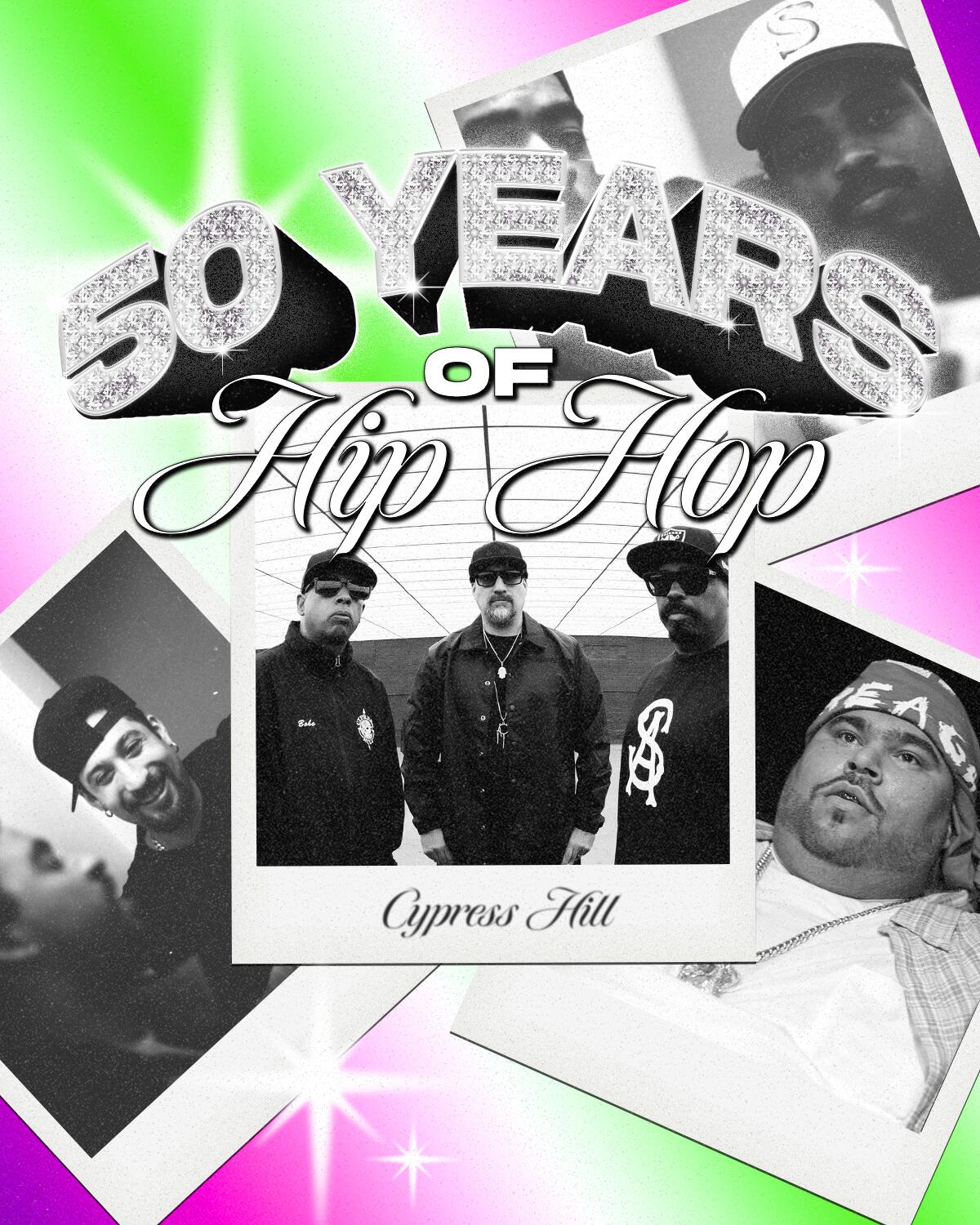Latinx Files: Remembering our contributions to hip-hop, 50 years later

It’s official: This Friday marks the 50th anniversary of the genre we now know as hip-hop.
According to its lore, hip-hop was birthed from an epic house party in the Bronx, dated Aug. 11, 1973. As chronicled by L.A. Times contributor Keith Murphy in the “50 Greatest Moments of Hip-Hop History,” this shindig known as the “big bang of rap music” was actually a back-to-school fundraiser for neighborhood kids. Organized by a young Jamaican woman named Cindy Campbell, the party would be soundtracked by her kid brother, Clive, who we came to know as DJ Kool Herc: 2023 Rock Hall inductee and inventor of the intrepid dual-turntable technique that cemented hip-hop’s very foundation.
The Bronx, both then and now, is a multicultural hub where New York City’s African American, Caribbean and Hispanic communities have both clashed and convened in working-class struggle. Just as “necessity is the mother of invention,” so goes the adage, what’s essential to the magic of hip-hop is the ingenuity that comes with the hunger to survive by any means; that is, for better or for worse. A half-century later, hip-hop remains the language of the marginalized, and in its most ideal form, can provide a vehicle of solidarity between us all.
The Latinx experience chronicled
Get the Latinx Files newsletter for stories that capture the multitudes within our communities.
You may occasionally receive promotional content from the Los Angeles Times.
Yet the role of Latinos in hip-hop has been debated for just as long as it’s been around. In 2022, controversy ensued after Nuyorican MC Fat Joe stated on an Instagram live that the contributions of those who are Latino and Black — which, in this context, he uses to mean non-Hispanic Black people — were equal. “Lately, they talking about Latinos wasn’t in rap… We are from the Bronx, New York, s— happens. So when hip-hop started, it was half and half.”
Many of the genre’s O.G.s — African Americans, Caribbeans and Puerto Ricans alike — rapidly surfaced to voice their dissents. “It feels like every time we come up with something, outside forces are trying to take credit away from us,” said Lord Jamar, founding member of the group Brand Nubian, in a 2022 episode of his podcast. “We have no doubt Puerto Ricans were there, contributing to what we were doing in the beginning... It’s one thing to contribute something, it’s another to create it.” Ruby Dee, one of several Boricua MCs who got their start in the 1970s, insisted: “The stars of the show were the Black community. We were the co-stars, and we’re still here.”
Of course, the divide between Black and Latino artists is not so cut and dry when you consider the number of Black Latino MCs, from the members of Cypress Hill to Tego Calderón, for whom Blackness has been a critical component in their experience of Latinidad. The history of hip-hop is still, at its core, Black history, which has shifted and evolved with years of commercialization and cross-cultural exchange.
In celebration of hip-hop’s golden birthday, here’s a highlight reel — incomplete as it may be — of some noteworthy and highly influential Latinos who helped shape the genre.
Consider subscribing to the Los Angeles Times
Your support helps us deliver the news that matters most. Become a subscriber.
Ten years after its inception, the scene’s racial ethnic diversity was made evident in the 1983 film “Wild Style.” Produced by filmmaker Charlie Ahearn, the movie plays out like a fictional hero’s journey through the South Bronx, shadowing legendary graffiti artist Lee Quiñones and members of his street art crew, the Fabulous 5. (Crew member Fab Five Freddy, famously namedropped by Debbie Harry in the disco-hop jam “Rapture,” joined Blondie guitarist Chris Stein in producing music for the film.)
Featuring dance moves by famed B-Boy Richard “Crazy Legs” Colón, as well as freestyles by the Fantastic Five and the Cold Crush Brothers, the film is a riveting slice of hip-hop history. The Cold Crush Brothers were eventually signed by CBS Records, and performed the inaugural hip-hop show in Tokyo — where Puerto Rican DJ Charlie Chase enchanted revelers by melding breakbeats with salsa.
Meanwhile, in Los Angeles, radio station K-DAY began circulating the burgeoning new sound from New York. Future rap stars Ulpiano “Mellow Man Ace” Reyes, and his brother Senen “Sen Dog” Reyes, were first exposed to hip-hop after immigrating to South Gate from Pinar del Río, Cuba, as children.
After riffing with Cuban Mexican MC B-Real, as well as New York transplant Mixmaster Muggs, the brothers would form the proto-group that became Cypress Hill in 1988. Mellow Man Ace decided to venture on his own shortly after; he surfaced in 1990 with his only charting hit, a Spanglish rap titled “Mentirosa,” in which he paired his laid-back flow with samples from Santana classics “No One to Depend On” and “Evil Ways.”
The members of Cypress Hill continued to soldier on with hard-hitting but humorous, stoner-centric jams, such as the Grammy-nominated 1993 highlight “Insane in the Membrane.” The group eventually recruited Beastie Boy Eric “Bobo” Correa, son of Puerto Rican jazz percussionist Willie Bobo, who first played timbales live with the band at Woodstock ’94.
An increasing number of Chicanos began to impart their own perspective in West Coast hip-hop. MC Kid Frost, a protégé of West Coast rap star Ice-T, challenged the xenophobia and classism aimed at cholos in his 1990 single “La Raza,” which featured on his debut record “Hispanic Causing Panic.” The following year, he assembled the pan-Latino supergroup “Latin Alliance,” which included MCs from New York, Nicaragua and Spain.
“A lot of people want us to hide our culture, but what about the thousands of kids not given a chance to go to college?” Kid Frost told The Times in 1990.
In the Spanish-speaking world, the early works of the New York-born Puerto Rican wordsmith Vico C helped pave the way for rappers to thrive without speaking a lick of English. Take the flow of Residente, whose musical DNA can directly be traced back to Vico C’s 1990 track, “Me Acuerdo;” or Daddy Yankee, Ivy Queen and Tego Calderón, who teased out their own distinct styles from Vico C, as well as Panamanian reggae artists El General and Nando Boom, and set their pace to the progressive hybrid riddim of reggaetón.
(Personally speaking, Calderón’s 2002 single “Pa’ Que Retozen” has been the most-cited work in my interviews with today’s reggaetón superstars, from Bad Bunny to Myke Towers.)
Puerto Ricans and Cubans continued to be pillars of New York hip-hop throughout the 1990s and 2000s. (Peruvian rapper Immortal Technique, however, was one talented outlier.) As members of the Terror Squad lit up the mainstream airwaves in English — and topped the Hot 100 in 2004 with “Lean Back” — Queens rapper N.O.R.E. pivoted from his own Anglophone comfort zone and tapped into his Boricua heritage by collaborating with reggaetón’s finest in the 2004 crossover sensation and quinceañera staple, “Oye Mi Canto,” which helped popularize Daddy Yankee among English-language audiences. “If you’re proud to be Latino now,” spit N.O.R.E., “stand the f— up!”
Down in Florida, Cuban mix-master DJ Laz helped expand the Miami bass sound — “accidentally” invented by DJ Amos Larkins, and made famous by acts like 2 Live Crew — to the Spanish-speaking masses. This distinctly 305 sound planted a seed in the mind of young Pitbull, who, with co-signs from American superstars Lil Jon and Sean “P. Diddy” Combs, lorded over the radio throughout the 2000s and 2010s with his high-octane, bilingual flow. (We’ll save his pivot to house music for another newsletter.)
Today, the rebel spirit of hip-hop continues to live on in artists from Latin America and its diaspora. In the United States, Dominican American artists like Cardi B and Ice Spice are generating the buzziest verses, while regional Mexican hitmakers Fuerza Regida flaunt their South Central cred with guitar-trap fusion songs known as “corridos tumbados.” Reggaetón continues to woo audiences worldwide through the music of Bad Bunny, Feid and Rauw Alejandro, as Latin trap MCs Quevedo and Trueno dominate in South America and Spain. Come November, the Red Bull Batalla World Final — the biggest Spanish freestyle competition in the world — will touch down in Colombia, where Mexican MC Aczino will defend his title as three-time winner.
In case one newsletter isn’t enough to satiate your craving for Latinx hip-hop knowledge, here is a syllabus of essential texts, podcasts and films to peruse:
To watch:
You may have to dig through Amazon Prime or the YouTube stacks to rent “Wild Style” — there’s also the fascinating documentary, “From Mambo to Hip Hop: A Bronx Tale,” which was released in 2006.
To read:
In 2020, Vulture writer Gary Suarez elaborated on the socioeconomic conditions that gave way to hip-hop culture in his essay, “Before Pun Went Platinum: The Unsung History of New York Latinx Rap.” There’s also the 2014 article by Juan Vidal, “Latinos and the Gentrification of Hip-Hop;” as well as the essay by Juan Flores, “Puerto Rocks: Rap, Roots, and Amnesia,” which was published in the 2004 anthology, “That’s the Joint! The Hip-Hop Studies Reader.”
To listen:
Latino USA covers its bases in “A Latino History of Hip-Hop Part 1” and “Part 2,” as well as the smash podcast, “Loud.” Gata Eccleston’s “Perreo 101” is also a fantastic primer.
The Latinx experience chronicled
Get the Latinx Files newsletter for stories that capture the multitudes within our communities.
You may occasionally receive promotional content from the Los Angeles Times.




